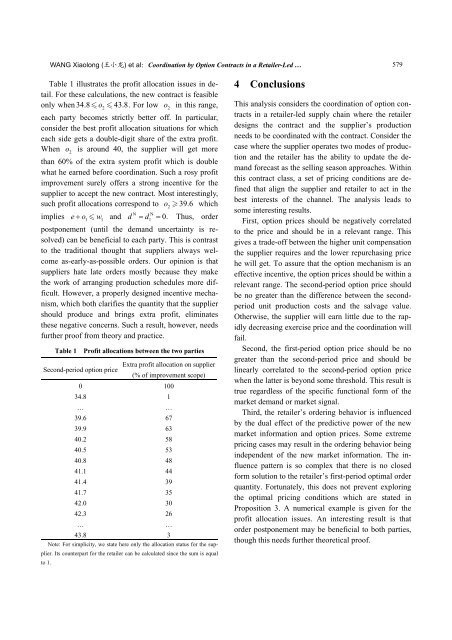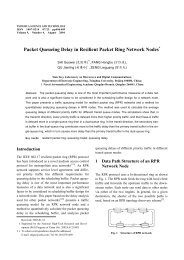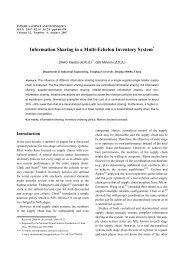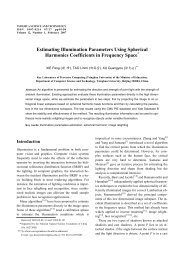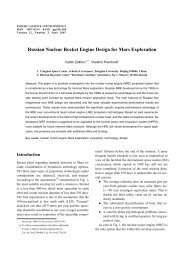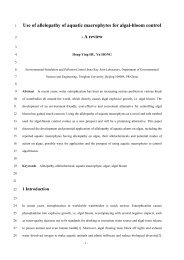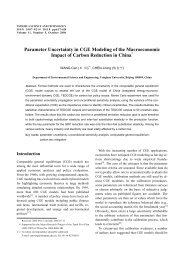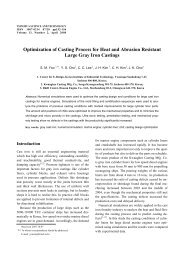Coordination by Option Contracts in a Retailer-Led Supply Chain with
Coordination by Option Contracts in a Retailer-Led Supply Chain with
Coordination by Option Contracts in a Retailer-Led Supply Chain with
You also want an ePaper? Increase the reach of your titles
YUMPU automatically turns print PDFs into web optimized ePapers that Google loves.
WANG Xiaolong (王小龙) et al:<strong>Coord<strong>in</strong>ation</strong> <strong>by</strong> <strong>Option</strong> <strong>Contracts</strong> <strong>in</strong> a <strong>Retailer</strong>-<strong>Led</strong> …<br />
Table 1 illustrates the profit allocation issues <strong>in</strong> detail.<br />
For these calculations, the new contract is feasible<br />
only when 34.8o2 43.8.<br />
For low o 2 <strong>in</strong> this range,<br />
each party becomes strictly better off. In particular,<br />
consider the best profit allocation situations for which<br />
each side gets a double-digit share of the extra profit.<br />
When o 2 is around 40, the supplier will get more<br />
than 60% of the extra system profit which is double<br />
what he earned before coord<strong>in</strong>ation. Such a rosy profit<br />
improvement surely offers a strong <strong>in</strong>centive for the<br />
supplier to accept the new contract. Most <strong>in</strong>terest<strong>in</strong>gly,<br />
such profit allocations correspond to o2 39.6 which<br />
N N<br />
implies e+ o1 w1<br />
and d = d1=<br />
0. Thus, order<br />
postponement (until the demand uncerta<strong>in</strong>ty is resolved)<br />
can be beneficial to each party. This is contrast<br />
to the traditional thought that suppliers always welcome<br />
as-early-as-possible orders. Our op<strong>in</strong>ion is that<br />
suppliers hate late orders mostly because they make<br />
the work of arrang<strong>in</strong>g production schedules more difficult.<br />
However, a properly designed <strong>in</strong>centive mechanism,<br />
which both clarifies the quantity that the supplier<br />
should produce and br<strong>in</strong>gs extra profit, elim<strong>in</strong>ates<br />
these negative concerns. Such a result, however, needs<br />
further proof from theory and practice.<br />
Table 1 Profit allocations between the two parties<br />
Extra profit allocation on supplier<br />
Second-period option price<br />
(% of improvement scope)<br />
0 100<br />
34.8 1<br />
… …<br />
39.6 67<br />
39.9 63<br />
40.2 58<br />
40.5 53<br />
40.8 48<br />
41.1 44<br />
41.4 39<br />
41.7 35<br />
42.0 30<br />
42.3 26<br />
… …<br />
43.8 3<br />
Note: For simplicity, we state here only the allocation status for the supplier.<br />
Its counterpart for the retailer can be calculated s<strong>in</strong>ce the sum is equal<br />
to 1.<br />
4 Conclusions<br />
579<br />
This analysis considers the coord<strong>in</strong>ation of option contracts<br />
<strong>in</strong> a retailer-led supply cha<strong>in</strong> where the retailer<br />
designs the contract and the supplier’s production<br />
needs to be coord<strong>in</strong>ated <strong>with</strong> the contract. Consider the<br />
case where the supplier operates two modes of production<br />
and the retailer has the ability to update the demand<br />
forecast as the sell<strong>in</strong>g season approaches. With<strong>in</strong><br />
this contract class, a set of pric<strong>in</strong>g conditions are def<strong>in</strong>ed<br />
that align the supplier and retailer to act <strong>in</strong> the<br />
best <strong>in</strong>terests of the channel. The analysis leads to<br />
some <strong>in</strong>terest<strong>in</strong>g results.<br />
First, option prices should be negatively correlated<br />
to the price and should be <strong>in</strong> a relevant range. This<br />
gives a trade-off between the higher unit compensation<br />
the supplier requires and the lower repurchas<strong>in</strong>g price<br />
he will get. To assure that the option mechanism is an<br />
effective <strong>in</strong>centive, the option prices should be <strong>with</strong><strong>in</strong> a<br />
relevant range. The second-period option price should<br />
be no greater than the difference between the second-<br />
period unit production costs and the salvage value.<br />
Otherwise, the supplier will earn little due to the rapidly<br />
decreas<strong>in</strong>g exercise price and the coord<strong>in</strong>ation will<br />
fail.<br />
Second, the first-period option price should be no<br />
greater than the second-period price and should be<br />
l<strong>in</strong>early correlated to the second-period option price<br />
when the latter is beyond some threshold. This result is<br />
true regardless of the specific functional form of the<br />
market demand or market signal.<br />
Third, the retailer’s order<strong>in</strong>g behavior is <strong>in</strong>fluenced<br />
<strong>by</strong> the dual effect of the predictive power of the new<br />
market <strong>in</strong>formation and option prices. Some extreme<br />
pric<strong>in</strong>g cases may result <strong>in</strong> the order<strong>in</strong>g behavior be<strong>in</strong>g<br />
<strong>in</strong>dependent of the new market <strong>in</strong>formation. The <strong>in</strong>fluence<br />
pattern is so complex that there is no closed<br />
form solution to the retailer’s first-period optimal order<br />
quantity. Fortunately, this does not prevent explor<strong>in</strong>g<br />
the optimal pric<strong>in</strong>g conditions which are stated <strong>in</strong><br />
Proposition 3. A numerical example is given for the<br />
profit allocation issues. An <strong>in</strong>terest<strong>in</strong>g result is that<br />
order postponement may be beneficial to both parties,<br />
though this needs further theoretical proof.


